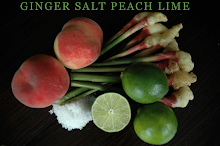
My last (and, let's face it, first) adventure with Japanese cooking was so successful I've just been lying about in my own brilliance and eating leftovers. As a result, I'm getting a bit full, so I thought I'd find out a little more about that root.
First of all, it really is as long as my leg. My legs are, by most standards, pretty short, but still. That makes for a long, spindly thing to be carried home from the market. Last Sunday when my grocery bags wandered into the near-sighted view of a fluffy Pekingese, she froze with legs splayed and eyes widened. I felt much the same. At least she didn't have to go home and cook the thing.
Burdock, or gobo in Japanese, is considered a herb, a strange thing to me because once in the grocery, it looks more like a dirty carrot stretched absurdly thin. When in the ground it's a thistle, growing wild in America and cultivated in parts of Europe and Asia. Its blooms look like mums or daisies. It has several aliases: personata, happy major, lappa, fox's clote, thorny burr, beggar's buttons, cockle buttons and philanthropium. Why we settled on burdock -- which sounds like a grumpy butler with the sniffles -- is beyond me. I'd much rather chop up some happy major or beggar's buttons and throw them in the pot.
Before that, however, there is the scrubbing. There's no sense in peeling a burdock. You'd be left with a cartoonish pile of shavings and no vegetable to cook. So, an impressive amount of scrubbing, and sink space, is needed to get this thing clean. Once that's done, the root must be quickly cut (in the Japanese kitchen, cut on the bias, like prettily sliced green onions) and soaked in cold water to avoid discoloration.
So why all this trouble? I've been asking myself the same question, and I've come up with two answers. It's relatively cheap (which probably translates into easy to grow) and it's nutritional value is right up there with leafy greens. And when your climate or pocketbook can't produce leafy greens, it makes sense you'd want a little burdock in your family's diet. Officially, it has iron, vitamins B and E, and it is particularly sought after in health food stores as a blood and body purifier. I'll let you figure out what that means on your own.
In the pot, once cooked, it tastes like a combination of asparagus and celery, crunchy and watery without being pushy or bitter. I've had it floating in a few miso soups, and it worked well in gomoku meshi. The problem is the recipe called for only one root, and the package at the grocery store offered two. Perhaps I could cut it in quarters and hope that Pekingese wanders by. She might like it better if it were more her size.


No comments:
Post a Comment